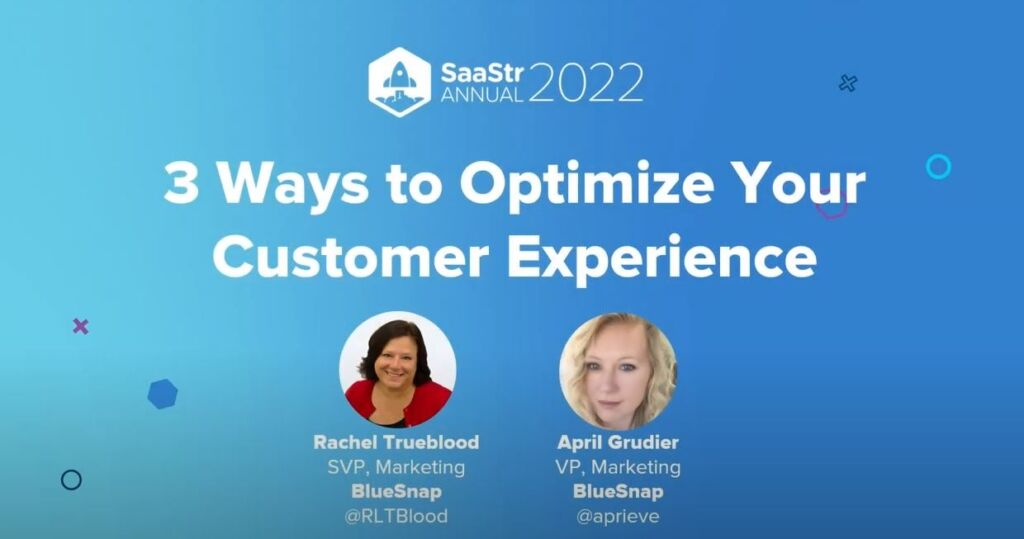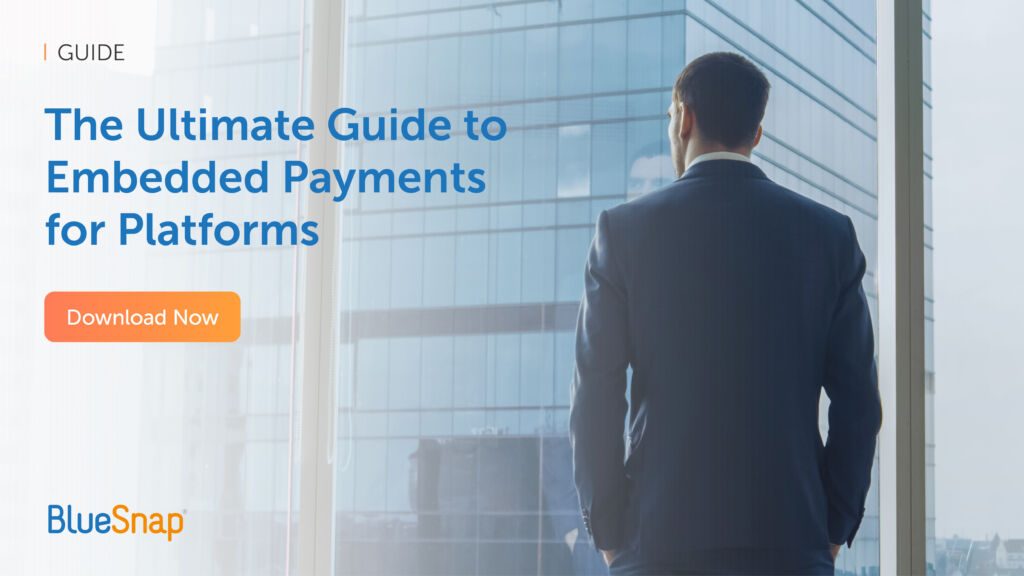In this video, BlueSnap experts CMO Rachel Trueblood and VP of Marketing April Grudier share some bright ideas about how you can improve your customer experience with payments.
Video Transcript
Rachel Trueblood: Hello everyone. Thanks for showing up. Seems like some of you are holdovers from the last presentation, so customer experience and customer expectations must be high on your priority list. While you’re here, I just wanted to take a few minutes to introduce myself. As she said, my name is Rachel Trueblood, and I work at BlueSnap. I’m our CMO, as well as I work with software platforms to help them optimize their customer experience through payments. I’ve been doing that for about eight years, and before that I spent about 17 years at Staples working on the customer experience at Staples.com and in our stores, and both in the US and Europe. I will let April introduce herself.
April Grudier: So hello. Thanks for joining us today. I’m April Grudier. I am the VP of Marketing and Partner Strategy at BlueSnap. And much like Rachel, I have been in the payment side SaaS side for about eight years. Prior to that, I was actually with Rachel at Staples. I’ve done B2C marketing for about – I hate to say it – 20 years. Don’t do the math. So both Rachel and I have been living and breathing customer experience for a very very long time, and a lot of the principles that we learned in B2C marketing, we’ve been able to transfer over to B2B.
So in full transparency I had a whole preamble set in introduction for this presentation, and then yesterday I was in the Cantina with one of my favorite colleagues Matt, who’s in the back – he wanted a special call out. And we sat down with a couple of gentlemen. We were talking to them about their experience SaaStr and some of the vendors they were meeting. And this one gentleman whose name escapes me, I apologize if you’re in the audience, was talking about a SaaS platform that he was using, and he was so enthusiastic about it. He was raving about it. He was saying, “Oh this platform makes my life so easy.” And we were talking to him about what it does and why it makes it so easy. And then we started talking about the price structure, and he said, “You know, honestly, I pay a premium. But I don’t mind paying that premium, because it makes my life so much easier.” And this story, I just told him was my introduction to this presentation, because my first stat talks about how 86% of buyers are willing to pay more for a better customer experience. And I thought, here’s this gentleman who is living and breathing this stat. He’s working with a SaaS platform that is just making things so much easier for him that he’s willing to pay more for it.
So what we’re going to talk to you today about is optimizing the entire customer experience. What you need to do is you need to take a look at the holistic experience of your customer journey, or your customer experience both inside and outside of your software. I’m going to talk to you a little bit about what that customer experience should be like or what you’ve been looking at inside the software, and Rachel’s going to talk to you about the three things that you should be thinking about outside your software customer experience.
As I was looking at this graphic earlier, it reminded me and anyone who studied psychology. It’s kind of like an inverted Maslav’s hierarchy of needs. When you’re thinking about within your software and that customer experience, obviously the first thing you’re thinking about is if your software is meeting the expectation of its promise. Is it doing the thing that your customer expects it to do? Are you thinking about utilization? Are you thinking about how people are using your software? Are they using it on desktop? Are they using it on mobile? Is it cloud-based? Do they need to download something? That all goes into the customer experience.
The next thing is personalization. How are you personalizing your software to make it user-friendly? To make it more intuitive? Are you allowing people to customize dashboards? Are you allowing people to customize in their preferred language?
The next thing to think about is engagement. You know, how are people engaging with your software platform? Are they using those special features that often some of us say, “Oh I don’t need that”? Are they using the extra features in your platform?
And then the last thing is the surprise and delight. Are there things you’re doing that allow you to surprise and delight in your platform. My surprise and delight moment today was when somebody opened up my LinkedIn app on my phone and taught me how to do the barcode scan, so that was my surprise and delight. I am now a lifelong user of that app.
So Rachel’s going to talk to you about those three optimizing bright ideas.
Rachel: Thank you. So I’m going to talk about customer experience maybe a little bit differently than you normally think of, because you normally think of what’s happening in your software. Are they getting onboarded in a most efficient and easy way? Are they using the features? Is the page designed well?
But one of the things that we have found software companies be really successful and really turn on the magic is when they think outside the box of their software. So how is your customer using the software outside of the features and functionality in your software in their daily role and their process of how they get their job done? Let me give you a little example just to bring that to life. We work with a student information system that’s very large, global. And what they really do is they help schools, K-12 private schools, keep one single record of all their student information – so their enrollment, their grades, their health records, their activities. Are they part of the drama club? Are they part of the football? And the very unique value proposition whether they had a single record for every student.
Before, each of the different departments in the school were keeping their own grades, keeping their own attendance records. But they had a light bulb moment, because what they did was they thought about, “OK, this is K through 12, and we’re hearing from our customers that our software is great but because we’re a private school, we also have all these fees and dues and donations. And we have to reconcile our spreadsheets, our ERP system, the way that they’ve been doing it for a hundred years with your software.” So they sort of have this lightbulb moment and they realize that the financial part of the student was inextricably linked to the student record themselves. So what they did was they brought payments into the student record, so now the school has one view of the student information, but also their payments. And that extends to their parents who now need to pay for football, outfits or renting a clarinet, or enrollment or donations. And what they found was their reconciliation as a school went from days to minutes, and it was that sort of student information system thinking more broadly about what their software can do and what problems they could solve for the school.
Another example is you know you think a lot about onboarding and how onboarding could be more simplified. And we have an example of, actually, a surgery platform. We work with all different kinds of software platforms, but this surgery platform is really focused on elective surgery. So it’s not like what your healthcare would cover. It’s what you pay out of pocket. And if you’ve ever had elective surgery, you pay your doctor, you
pay the surgeon, you pay the anesthetician. You might pay the hospital, so you’ve got all these bills and they all have to collect money. And maybe you know somebody’s a late payer and they go into collections, and there can be bad blood between all of those people when it comes to, “Did that patient that you referred to me actually pay their bill?”
So this surgery platform was trying to coordinate all these multi-party payments and providers. What they did was they said, “OK. What if we could onboard all of the parties in a procedure together so that the patient only has to deal with one provider?” And that provider can divvy up the payments across all of the different constituents within the operation. And then each of them don’t have to deal with collections anymore, don’t have to deal with invoicing, don’t have to deal with reconciliation. And it provides a really seamless experience for both the doctor as well as the patient. So they take onboarding at a broad, global level and look at all of the constituents within the surgery itself.
And then our last example is, are you making it easy for customers to use their data? I think I’ve been to a bunch of different booths and there are a lot of different data providers. Data is king, and each platform each of your software probably has your own reporting, your own data that you capture. But how is your customer using that data with all of the other systems they use? With their ERP system? With their order management system? With, you know, maybe their POS?
And what that means is you take your sales, your regions, your customers. You want them to be able to reconcile in an easy way, so it’s really about having payments be the lifeblood of the business. And each business customizes it, so how do you take your standard reporting, give them customization, allow them to with APIs to bring it into the systems that they use day in and day out and pre-integrate with the platforms that they use today?
So that was the fastest 10 minutes ever. So just to wrap up, you know the three things that if you’re going to take away anything, take away this: think outside your box. You know, how does your customer experience fit into the day-to-day life of your customers and their experience and the things that they’re doing.
The next bright Idea is ready, set, glow. Does your boarding take a holistic view of the customer? Are you really thinking about how users are boarding onto your platform?
And then bring those insights to life. You know are you making it easy for customers to use their data. Are you able to sync with other points of data to give customers the ability to really make sound strategic decisions about their business?
So, again, fastest 10 minutes ever. I’m Rachel and I love talk about customer experience. If you’re interested in talking more or you have questions, stop by our booth.
April: It’s 249, or you can reach out to us at these email addresses. Or if you stop by the booth, I can show you now how to use that LinkedIn app scanner. Thank you very much.
Related Resources:


